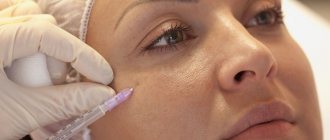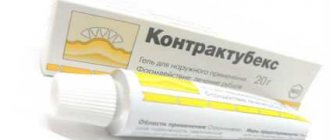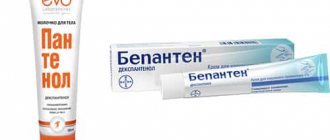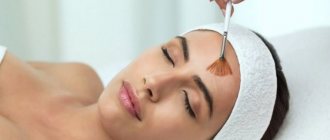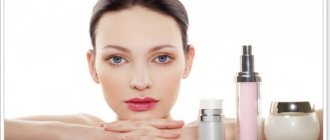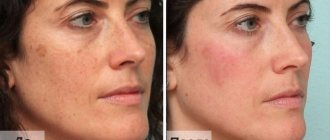The secret to effective innovation
An innovative method of cleansing and rejuvenating the skin became known recently, in 2000. It was first proposed by French mesotherapists. The innovation underwent a number of clinical studies in Brazil and quickly conquered patients and cosmetologists around the world.
Mesopeeling is a cosmetic procedure that provides a mid-peeling effect, but the patient does not experience significant peeling or post-peel side effects. Mesopeeling involves the introduction of a 1% acid solution 1–2 mm deep into the skin in certain doses. The acid composition is delivered to the epidermis and begins to actively influence the problem from the inside.
The mesopeeling procedure is aimed not so much at cleansing as at eliminating skin imperfections (wrinkles, loss of tone, enlarged pores, etc.).
Not only does this technique provide an increased effect in a short time, it eliminates injury to the integrity of the skin, does not cause extensive peeling, the development of severe redness after the procedure and inflammatory processes. It is these qualities that mesopeeling has earned mass recognition and popularity.
Please note that mesopeeling should only be performed by first-class cosmetologists. Incorrect dosage of an acidic agent during injection or violation of the drug administration technique reduces the quality of the procedure and the final result.
The combination of peeling and mesotherapy in one procedure is considered a major breakthrough in the development of modern cosmetology. Mesopeeling combines the best properties of these two procedures.
The innovative technique has many advantages compared to classical procedures:
- absence of pain and burning during execution, which are present with conventional acid peeling;
- carried out without anesthesia or painkillers;
- the technique allows you to cope with imperfections of the epidermis in the sensitive area around the eyes and mouth;
- lasting effect;
- Mesopeeling can be carried out at any time of the year;
- high efficiency of the method and quick results;
- no special preparatory measures are required before mesopeeling;
- an extensive list of indications that the innovative technique is ready to handle;
- no rehabilitation or restrictions in care, slight redness of the treated areas on the face disappears after 20–30 minutes;
- the composition of the drug for injection is selected taking into account the type of epidermis and its problems;
- absence of post-peeling swelling, blue discoloration, peeling and persistent erythema.
The mesopeeling procedure has significantly facilitated the tasks assigned to cosmetologists in rejuvenating and eliminating skin problems. Immediately after the procedure, the face becomes fresher and looks younger, and the shade of the epidermis is evened out. You can judge the full effect after a course of mesopeeling, after 1–1.5 months.
The gentleness of the effect, the safety of the process and the low concentration of acid allow the procedure to be carried out even during pregnancy and lactation.
Combination of mesotherapy and glycolic peeling
Glycolic acid is characterized by a complex effect on the skin, which affects the main links in the pathogenesis of skin aging:
- exfoliation of the stratum corneum; the uniqueness of the action lies in the fact that the size of the molecule is very small, and this promotes deep penetration of the acid, where it destroys desmosomes (connections between corneocytes), imitating and forcing the physiological process of exfoliation of cells of the stratum corneum, which results in an improvement in complexion and the skin acquires healthy and radiant appearance;
- irritation of skin receptors provokes vascular and inflammatory reactions, and also promotes the release of mediators that stimulate regeneration processes in the skin;
- stimulation of keratinocytes promotes restructuring, renewal and thickening of the epidermal layer;
- stimulation of fibroblasts blocks degenerative phenomena in the elastic and collagen fibers of the dermis. The result is an increase in skin turgor and elasticity. The skin becomes elastic, wrinkles are smoothed out.
However, this procedure carries a risk of complications, such as:
- prolonged congestive erythema,
- hyperpigmentation,
- infectious complications,
- Sometimes glycolic peels cause acne to worsen.
The combination of mesotherapy and glycolic peeling procedure allows you to prepare the skin for aggressive effects and minimizes the risk of complications . Glycolic acid in cosmetology gives a pronounced therapeutic result and rehabilitation in a shorter period of time.
In what cases is it advisable to recommend this combination:
- prevention of skin aging caused by stressful situations, smoking, excessive insolation, as well as immune and endocrine factors;
- glycolic acid in cosmetology helps if there is deep skin dehydration, superficial wrinkles, reduced turgor and elasticity;
- post-acne (prevention and correction of scar changes);
- preparing the skin for the correction of atrophic scars and other skin defects with fillers, as well as for the introduction of implants;
- peeling with glycolic acid and mesotherapy help prepare the skin for plastic surgery, deep and medium peels in order to optimize the final result and reduce the rehabilitation period;
- skin rehabilitation after plastic surgery.
Planning the course is preferable in late autumn and/or early spring, depending on the condition of the skin, 1-2 times a year. Recommended course: 6-8 procedures once a week Conventionally, the course can be divided into a preparatory stage and, in fact, the course itself.
At the preparatory stage, the patient takes orally fat-soluble antioxidants, zinc, selenium, omega-3 acids, coenzyme Q two weeks before the start of the course and throughout the course. Dysfunction of the antioxidant system, associated with an increase in reactive oxygen species and activation of free radicals as a result of lipid peroxidation, has a negative impact on cellular homeostasis in general and on the skin in particular. Therefore, it is so important to create a depot of antioxidants in advance, which will prevent free radical induction of melanogenesis and oxidative stress from subsequent glycolic peels, and also strengthen the overall immune status.
Along with taking antioxidants internally, it is recommended to use external creams containing glycolic acid 5-10%, pH at least 3.5 for 10-14 days and fat-soluble antioxidants.
At the main stage, mesotherapy and glycolic peeling procedures (first peeling, then mesotherapy) are combined in one procedure with an interval of 8-10 days, or peeling is carried out first, mesotherapy is carried out in the next three days, and peeling again after 7-8 days.
As in a standard course of glycolic peeling (4-6 procedures), it is necessary to comply with the rehabilitation period; within 4 days after peeling, use skin regeneration preparations with glycolic acid. In addition, glycolic peeling requires the use of sunscreen throughout the entire course. The concentration of glycolic acid for procedures is selected individually and depends on the biological resource of the skin.
Mesotherapy is carried out with the aim of strengthening the antioxidant system of the skin, reducing the likelihood of melanogenesis, improving the quality of regeneration and reducing the rehabilitation period. As in the classic course of mesotherapy, drugs are selected individually.
Among the antioxidants used are drugs such as:
- ubiquinone,
- vitamin E,
- drugs that improve blood supply to tissue: lofton,
- pentoxifylline.
- D-panthenol,
Add to cocktails:
- local anesthetics;
- procaine;
- coenzymes (cocarboxylase) to enrich cells with oxygen and energy to carry out synthetic processes: proliferation and neocollagenesis;
- oligoelements Se, Zn;
- organic silicon preparations that provide regeneration by accelerating division and have an antioxidant effect. They retain free radicals that destroy cell walls, and also effectively restore skin elasticity - increases the biosynthesis of collagen and elastin.
- hyaluronic acid maintains the necessary level of moisture, restores and protects the skin.
- The Ribomunil vaccine is used to prevent exacerbation of acne.
Peeling with glycolic acid is often carried out using ready-made cocktails, which contain substances that stimulate the natural restoration of the skin, a complete “material” for cell growth. They promote the active formation of collagen, elastin and hyaluronic acid, which radically improves skin quality.
It should be remembered that not everyone is ready to gain youth at any cost, which is why “conservative” procedures in cosmetology are so relevant, with the shortest rehabilitation period, although sometimes more expensive. Everyone wants a guaranteed and safe (without complications) result! In this case, peeling with glycolic acid and mesotherapy provides many benefits. Effective prevention of oxidative stress and melanogenesis, improving the quality of regeneration and reducing rehabilitation time. After all, it is important for us not only to improve the quality of the procedure, but also not to cause harm.
The material was prepared by Marina Son , dermatologist-cosmetologist
Who is the procedure recommended for?
The innovative technique has a considerable range of indications typical for different age categories. These include:
- hyperkeratosis;
- chrono- or photoaging;
- loss of skin tone;
- rapid rate of appearance of wrinkles and facial folds on the face;
- pigmentation, freckles and congestive acne spots;
- comedones, blackheads;
- “goose bumps”, enlarged pores;
- shallow scars, stretch marks and scars;
- dryness, feeling of tightness;
- oily sheen, disruption of the sebaceous glands;
- problematic acne, frequent acne;
- seborrhea;
- vitamin deficiency of the skin, unusual grayness and dullness of color.
Mesopeeling is recommended to be used not only purposefully to solve existing skin problems, but also as a preventive measure.
Specifics of mesopeeling
Just by the name of the procedure, it becomes clear that we are talking about a serious event of a purely salon type: the combination of such phenomena as “peeling” and “mesotherapy” simply cannot take place in an environment that is not equipped with the appropriate equipment to implement such an event. Indeed, mesopeeling today means serious cleansing of the facial skin using glycolic acid, injected in strictly defined doses under the skin (at the meso-tissue level). This procedure is carried out by qualified specialists, and according to approved methods. Although it is believed that the one percent glycolic acid used in this case with some additives is as safe as possible for patients, they try to administer it carefully and without violating the technology, we are still talking about the most important thing for a woman - her face.
Photos before and after the mesopeeling procedure
This cosmetic procedure has a huge number of advantages:
- Due to the effect of acid exclusively on the subcutaneous tissue structures, the skin of the face does not feel any negative manifestations or effects. In this case, there is no redness, burning, or peeling. The only painful phenomenon that is noted by patient reviews and which is observed within the framework of this technique is the effect of the needle penetrating the skin, everything else passes quickly, easily and painlessly.
- The technique eliminates any side effects (especially in the form of scars, swelling, bruises), it is highly accurate and effective for all types of skin. Moreover, it has no contraindications. You can do mesopeeling even during pregnancy. It is safe, convenient and, most importantly, effective.
- Cosmetologists also note the minimal risk of allergic reactions, achieved through the use of extremely small doses of drugs. A minimum of acids and substances dissolved in them is a maximum of protection against possible rejection of these elements by the body.
- Finally, the effect of using the technique is quite good and, moreover, noticeable almost immediately. This method of influencing facial tissue helps get rid of blackheads, acne and scars from them, reduces excessively enlarged pores, and eliminates skin hyperpigmentation.
Who benefits from glycolic acid facial treatment?
If you study the photos of the majority of beauty salon clients who order this procedure for themselves at intervals of about once a week, it turns out that the vast majority of these patients are ladies with certain problems. In particular:
- Women with age spots and the first deep wrinkles on the face
- Girls with acne and scars on the face left after acne removal
- Ladies with inflamed skin or tissues that are constantly prone to redness and irritation
- Representatives of the fairer sex with typical makeup problems: blackheads, inelastic skin, excessive sebaceous glands, poor complexion, etc.
How mesopeeling procedures are performed
You can watch the whole process in this video:
In most cases, mesopeeling is recommended to be carried out no more than once a week (otherwise it will be a lot of stress for the subcutaneous structures). In this case, the procedure can be either single or part of a whole complex of several sessions. It all depends on the specifics of the problems that need to be solved, as well as on the course prescribed by a personal cosmetologist.
As a rule, between procedures for the introduction of glycolic acid, accompanying events are also arranged, designed to enhance the effect of mesotherapy in combination with peeling. Experts, for example, recommend moisturizing the skin with special creams and products, nutritious nutrition, and careful care for it.
Types of mesopeelings
Mesopeeling procedures may differ from each other in the composition used. The final result largely depends on what acid is included in the product. For example, if you experience weakening tone and turgor, wrinkles appear and all the signs of aging are evident, cosmetologists will recommend using retinol (vitamin A). It will have an enhanced rejuvenating effect and cleanse the skin.
Several acids are used to transform the face. Let's consider their action and determine in which cases it is better to use them:
- Lactic acid – suitable for patients with sensitive and very sensitive skin. Lactic acid is found in small amounts in skin cells, so it does not cause rejection or any complications. In addition, lactic acid has an antimicrobial, healing effect;
- glycolic acid – has a moisturizing and rejuvenating effect. This component activates the production of collagen fibers and elastin and prevents aging. Mesotherapy with glycolic acid is ideal for patients suffering from dry epidermis and flaking. Glycolic acid molecules slow down the formation of natural melanin, which delays the appearance of pigmentation on the face;
- the addition of retinol is used for mature skin. Retinol has a high anti-aging effect, increases its protection and helps lighten age spots and congestive spots;
- salicylic acid - ideal for problematic and oily epidermis. The main component fights acne, pimples and inflammatory processes from the inside. The disadvantage of salicylic acid is a high risk of irritation, compared to glycolic or lactic acids. Follow your cosmetologist's recommendations to minimize this risk.
Regardless of the chosen composition, mesopeelings cannot be performed at home. Only professional execution guarantees high efficiency in correcting skin defects.
Which is better to choose?
The decision to choose peeling or mesotherapy is made individually. Getting your skin in order by peeling will cost less . But the cost will depend on the variety chosen. There are several types of peeling and each has its own characteristics. This procedure can also be performed at home.
Attention! If you have time and money, it is worth taking a course of mesotherapy. But it is better to consult a cosmetologist. He will assess the condition of the skin and recommend the most effective procedure in a particular case.
The vitamin cocktails used during processing are almost identical . For this reason, both techniques can be used separately or together. The combination results in mesopeeling.
We recommend: Is peeling allowed while breastfeeding? What procedures can be done?
Peeling before mesotherapy
The classic option involves performing mesotherapy after peeling with a difference of 4–9 days.
There is another possibility: on the eve of mesotherapy, peeling is performed, and then for 3 days the cosmetologist gives beauty injections . After 7 days, you can repeat exfoliation.
During the recovery period of the epidermis after exfoliation, it is necessary to use creams containing glycolic acid and products intended for sun protection.
Is it possible to do it at the same time: a combination of procedures
The combination of exfoliation and mesotherapy is based on a vitamin cocktail containing hyaluronic acid. Its concentration is 1–2%.
The benefits of mesopeeling include:
- mutual enhancement of the effect of acids;
- reduction of the rehabilitation period;
- minimal trauma;
- pronounced effect of rejuvenation and whitening;
- the possibility of performing the procedure in summer, when the sun is active;
- penetration of acids into deeper layers of the skin.
Mesopeeling is suitable for women of all ages.
But such a combination of cosmetic techniques is not without its drawbacks. The injection sites remain sore, sometimes bruising and redness appear . The possibility of developing an allergic reaction cannot be ruled out.
The course consists of 3–7 procedures at weekly intervals. A slight lifting effect and evening out the tone of the epidermis are visible almost immediately.
On a note! The combination of procedures is especially effective for facial rashes caused by hormonal imbalance.
In combination with mesotherapy, superficial exfoliation is used, which affects the outer layers of the skin. Beauty injections are given into the middle layers of the epidermis, due to this the procedures do not overlap each other in their action.
Mesotherapy before peeling
If you ask a dermatologist whether it is permissible to perform peeling after beauty injections, he will say that it is possible.
This is done in order to enhance the effect. Peeling after mesotherapy, as well as before, increases the effect of hyaluronic acid , helps saturate cells with oxygen, and doubles the achieved result.
When exfoliation acts as a preparatory step for mesotherapy, the main component of vitamin cocktails – hyaluronic acid – creates the conditions for prolonged cell activity. The use of peeling after revitalization makes the rejuvenating effect more pronounced. The results obtained last longer.
We recommend: Chemical peeling with salicylic acid. Why and how is it carried out in the salon and at home?
Technology and care after the procedure
In terms of technique, the procedure resembles classical mesotherapy. No preparation is required from the patient before performing the technique.
The transformation process is simple, but requires professionalism and skills in injection cosmetology:
- The face is cleaned of dust particles, fatty deposits or makeup residues. To do this, use a cleanser (milk, lotion).
- Using a special needle, the drug is injected 1–2 mm into the skin. First, the cosmetologist goes over the entire face, and then separately treats wrinkles, scars and problematic folds.
- At the end of the injection, the remaining product is removed and the cream is applied to the face.
Before mesopeeling, the cosmetologist checks how the skin reacts to the exfoliant. If irritation and unusual effects occur, the composition is replaced with another.
Mesopeeling does not involve complications or side effects, so the patient can immediately go home and do their usual activities.
There is no rehabilitation period as such, but certain recommendations must be followed. For example, experts advise using creams and cosmetic products for the skin that promote rapid restoration of the skin and prevent peeling.
How many procedures will be required
Mesopeeling is carried out in courses of 3–7 sessions, in some cases their number can be increased to 10. The duration of the course is selected by the cosmetologist solely based on the characteristics of the skin and the degree of defects on the face.
Mesopeeling should be carried out depending on the structure of the skin. It is allowed to perform such procedures once every 7 days for patients with thin and sensitive skin. If your skin is oily, thick or problematic, then sessions are held every 3-4 days.
To increase the effectiveness of manipulations, it is recommended to alternate mesopeeling with classical mesotherapy.
How does mesopeeling roll for face work?
Libriderm peeling roll for face chamomile juice 75ml
Peeling products in the form of a roll came to us from Asian countries, where they are very popular. In South Korea, Japan, China and other countries, facial scrubs are practically not used; their place is taken by soft and delicate acid-based peels that can dissolve the surface layer of dead cells. With massage movements, such cells are easily separated and rolled into small pieces, which can then be easily washed off. After the procedure, the skin appears fresh and clean, a natural glow appears and the complexion improves.
If this procedure is performed on aging skin, it is possible to partially eliminate hyperpigmentation, remove dull and gray skin tone, and eliminate fine wrinkles that appear on the surface of the skin due to excessive dryness.
You can use skin preparations on any skin, but for dry and sensitive skin you need to choose a more delicate product that better nourishes and moisturizes it.
For oily or combination skin, the peeling roll has an excellent effect. The drug helps reduce oily skin, slightly tightens pores and helps cleanse them, lightens blackheads and makes them less noticeable.
Not only numerous Asian and Western companies are now producing such products. Preparations of this type have also appeared in Belarusian cosmetics. For example, the mesopeeling roll from the MEZOCOMPLEX series from Belita - Vitex caused a huge flurry of positive reviews due to its amazing properties and minimal price.
The use of the pellet cannot be considered as effective as injection mesopeeling, but in their composition they are very similar. For example, the above-mentioned mesopeeling in a roll from a Belarusian manufacturer is based on lactic acid, which is also used in classic injection mesopeeling. Yes, the roll gives a softer result, but it can be successfully used in between procedures at home to maintain the effect for a longer time.
Contraindications
Patients with contraindications will have to refrain from the innovative transformation technique:
- Allergic reaction to the product used;
- Hemophilia and other diseases associated with poor blood clotting;
- General malaise, fever;
- Herpes in the acute stage;
- Tendency to keloid scarring.
Before performing mesopeeling, carefully read the reviews about the clinic staff and the qualifications of the cosmetologist. Feel free to inquire about the availability of relevant documents (certificates).
Mesopeeling guarantees an improvement in the condition of the skin without pain or unpleasant consequences. Immediately after the procedure, you will notice a fresh and healthy complexion, smoothing of wrinkles and folds.
